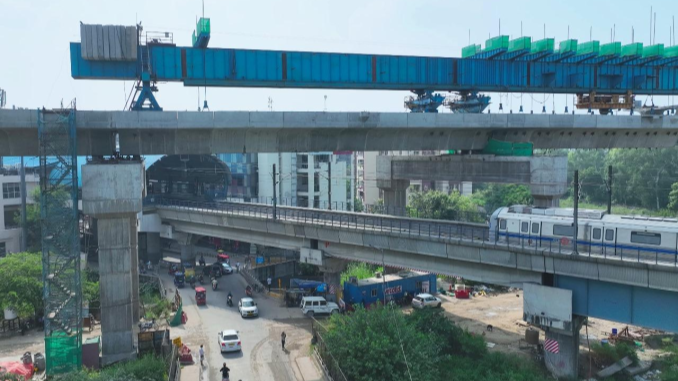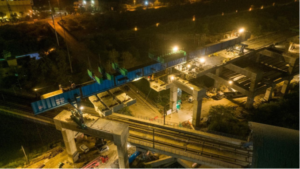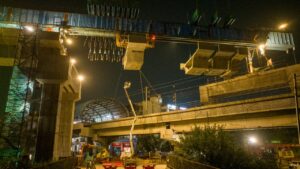
NCRTC successfully completed the construction of the viaduct of RRTS corridor crossing over the Blue Line of Delhi Metro corridor. The RRTS corridor crosses Delhi Metro at a height of about 20 metres at this point near the New Ashok Nagar Metro Station.

More Details:
- Being constructed as a part of a long-term strategic solution to the pollution and congestion conundrum of Delhi, the Delhi-Ghaziabad-Meerut RRTS corridor has achieved an important milestone in Delhi.
- This viaduct of the RRTS corridor crosses the Delhi Metro corridor at a height of about 20 metres at this point near the New Ashok Nagar Metro Station. Carrying out construction work at such a height over the existing and already operational metro track successfully is a big achievement from the engineering point of view.
- Moving from Sarai Kale Khan RRTS station towards New Ashok RRTS station, the elevated alignment of the RRTS corridor is crossing the viaduct of the blue line of Delhi Metro which provides services to a large number of people every day.
- To ensure the convenience and safety of commuters travelling from this station, construction of this part of the viaduct has been done during the night time only with the help of Tarini (Launching Gantry).
- In this process, segments of the girder were lifted and joined together to construct the full span of the viaduct. NCRTC received unwavering support from DMRC during this whole construction. The construction was completed safely by NCRTC while ensuring uninterrupted services of the metro.
- Multi-modal integration is the guiding principle of the RRTS project being implemented by NCRTC. To facilitate this, RRTS stations have been strategically planned in such a way that they can be built as close as possible to the existing modes of public transport.
- Provisions have been made to provide seamless connectivity for a smooth and uninterrupted travel experience for commuters. NCRTC, while ensuring this, has also had to face many complexities related to construction and civil engineering but with innovative techniques and strategic planning, it was made possible.

- New Ashok Nagar Metro Station receives a large number of commuters from Noida. Once the RRTS corridor is operational, commuters would have the option to travel towards Meerut or other RRTS corridors from this station.
- To provide connectivity between RRTS station and metro station at this point, NCRTC is constructing a about 90-metre-long and 6-metre-wide Foot Over Bridge (FOB) which will be connected from the concourse level to concourse level of both the stations.
- The height of this FOB will be 8 metres above the ground. This will facilitate seamless movement of commuters between both the modes of transport without exiting the station premises. This will also ensure stress-free travel for commuters and play a major role in controlling traffic jams and congestion outside the station.
- It will especially ensure a convenient and comfortable travel experience for women, the elderly, children, and commuters travelling with luggage. Moreover, to provide better connectivity and accessibility to the station from the nearby areas, NCRTC is also constructing two more FOBs at this station to connect residential areas.
- So far, construction of a more than 5-kilometre-long viaduct has been completed in Delhi out of a total 9 km elevated section. 90 per cent of the pillar construction work has also been completed. Delhi has around 14 km long section, the rest is the underground section for which construction of tunnels have already been completed.
- NCRTC aims to operationalize the entire Delhi-Ghaziabad-Meerut corridor by year 2025. Before that, the 17-km long Priority Section will be commissioned for the public soon this year.
Source: NCRTC- Press Release | Images Credit: NCRTC

